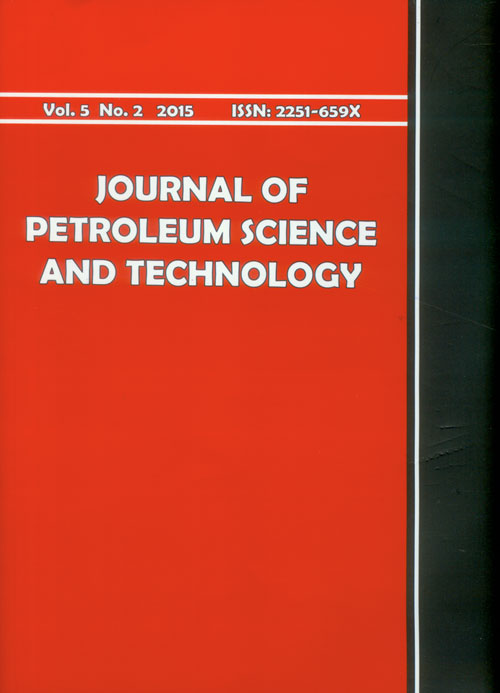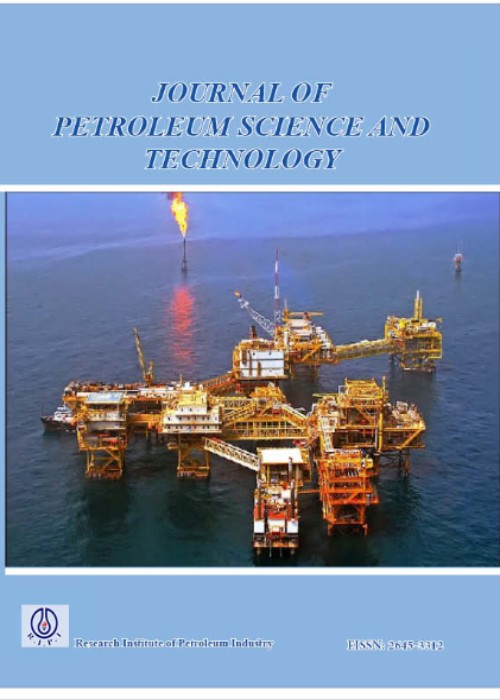فهرست مطالب

Journal of Petroleum Science and Technology
Volume:5 Issue: 2, Summer 2015
- تاریخ انتشار: 1394/05/06
- تعداد عناوین: 8
-
-
Pages 1-11The corrosion protection of mild steel by a newly developed epoxy-based coating system containing inherently conducting nanopolyaniline-clay as a nanoadditive has been studied. Polyaniline-clay anticorrosion nanoadditive (PCNA) was obtained by the direct mixing method of nanopolyaniline (0.03 wt.%) and organo-modified clay (3 wt.%) at atmospheric pressure, and XRD technique was used to study d-spacing of clay platelets in the prepared nanoadditive. PCNA was dispersed in polyaminoamide hardener matrix and was used for epoxy coating (EPCNA) preparation. The particle size of the polyaniline in hardener was determined using dynamic light scattering technique (DLS). The results revealed that the particles were in the range of 50–58 nm. The degree of exfoliation and distribution and particles size were studied by XRD and TEM in the final dried film. The corrosion protection ability of EPCNA was compared to an epoxy coating containing pure nanopolyaniline (ENPN) using electrochemical impedance spectroscopy (EIS) and salt spray methods. In addition, an investigation on the morphology of metal-coating interface by scanning electron microscopy (SEM) technique in ENPN and EPCNA samples after salt spray test showed stable oxide layer formation for ENPN and a dense stable oxide layer for EPCNA on metal surface. The results showed that the PCNA nanoadditive enhanced corrosion protection effect in comparison to pure nanopolyaniline (NPN) in the epoxy coating.Keywords: Nanoadditive, Nanopolyaniline, Nanoclay, Anticorrosion, Epoxy Coating, EIS
-
Pages 12-28Prior to the implementation of CO2 injection EOR projects, the screening evaluation of candidate reservoirs will promote the economic benefits of CO2 injection. Currently, a uniform screening method for CO2 miscible flooding does not exist. Based on more than 112 successfully implemented CO2 miscible flooding reservoirs, which was referred in 2010 Worldwide EOR Survey, and CO2 miscible flooding mechanisms, this paper picks out 12 reservoir and fluid parameters affecting CO2 miscible flooding results as comprehensive evaluation parameters for screening candidate reservoirs. According to investigations on a large number of domestic and international CO2 miscible flooding projects, the quantitative methods are determined by theoretical analyses, field experience, and probability statistics. By means of calculating the combinational weights by improved analytical hierarchy process (AHP) and entropy method and combining the advantages of technique for order preference by similarity to ideal solution (TOPSIS) with gray relational analysis to construct a new similarity nearness degree, the weighted GC-TOPSIS model is established for screening candidate reservoirs. This screening method was employed for the assessment of five classical candidate reservoirs proposed for CO2 miscible flooding. The results show that this new method can correctly evaluate and compare the potential of CO2 miscible flooding.Keywords: CO2 Miscible Flooding, Screening Index, Evaluation Criteria, Ideal Solution, Grey Correlation
-
Pages 29-35In this investigation, attempts were directed to study the inhibitive effects of nitrite and phosphate base inhibitors for the carbon steel alloy samples, which are used in an acid gas treatment process (The SULFIRAN® solution), in Fe-EDTA solution. Electrochemical techniques, i.e. polarization curves and electrochemical impedance spectroscopy (EIS), were used to evaluate the inhibition efficiency. Linear polarization resistance (LPR) and weight loss techniques were also used to determine the corrosion rate for the pilot tests. The results indicated that adding inhibitors reduced corrosion rate to some suitable values (<5 mils per year (mpy)). For both inhibitors, the inhibition efficiency increased with the inhibitor concentration. The results showed that the inhibition efficiency of the phosphate base inhibitor was less than the nitrite base inhibitor.Keywords: SULFIRAN® Process, Iron Chelate Solution, Corrosion Inhibition, Carbon Steel
-
Pages 36-44The Biqian-10 block, located in Henan Oilfield of Sinopic, contains many thin and interbedded reservoirs, which have been operated by cyclic steam stimulation for 20 years or more. Therefore, it is a challenge to implement the conventional steam flooding. In order to improve the recovery of steam flooding, urea was used to assist steam flooding. Urea can decompose into CO2 and NH3, which are beneficial to enhance oil recovery (EOR). For the sake of exactly quantifying the mechanism of urea assisted steam flooding (UASF), the UASF model was built according to the experimental results. The simulation results show that CO2 is the key point for EOR, and its pressurization function is more effective than the decrease in oil viscosity by dissolving CO2. The emulsification of crude oil for NH3 is weak in interfacial tension tests; thus the effect of emulsification can be ignored in the simulation. The UASF can improve the recovery by about 17.4%, which is 6.8% higher than steam flooding.Keywords: heavy oil, urea assisted steam flooding, CO2, mechanism, EOR
-
Pages 45-50Heavy alkylated benzene (HAB), which is a by-product in linear alkylbenzene (LAB) production by UOP process, is separated by distillation from LAB and consists of a range of components such as polyalkylbenzenes, diphenylalkanes, alkyl tetralins, and alkylindans. The products of sulfonation of HAB or its distillation cuts are of wide industrial applications such as emulsifiers, dispersants in lubricating oils, anionic surfactants, and aqueous phase stable waterflooding. The sulfonation of the HAB mixture using oleum as the sulfonating agent has been carried out and optimum reaction conditions have been defined based on the highest degree of sulfonation. Some light, average, and heavy distillation cuts were then sulfonated under optimum conditions. The degree of sulfonation of the fractions was found to be dependent on the composition of the mixture. 1HNMR spectroscopy was used to investigate the relationship between the ratio of aliphatic to aromatic protons of the compounds and the trend in sulfonation.Keywords: Heavy Alkylated Benzene, Sulfonation, Oleum, Alkylbenzene, Tetralin, Indan, Diphenylalkane
-
Pages 51-58Formation micro imager (FMI) can directly reflect changes of wall stratums and rock structures. Conventionally, FMI images mainly are analyzed with manual processing, which is extremely inefficient and incurs a heavy workload for experts. Iranian reservoirs are mainly carbonate reservoirs, in which the fractures have an important effect on permeability and petroleum production. In this paper, an automatic planar feature recognition system using image processing was proposed. The dip and azimuth of these features are detected using this algorithm to identify more precise permeability and the career of fluid in reservoirs. The proposed algorithm includes three main steps; first, pixels representing fractures are extracted from projected FMI image into location matrices x and y and the corresponding value matrix f(x, y). Then, two vectors X and Y as the inputs of CFTOOL of MATLAB are produced by the combination of these three matrices. Finally, the optimum combination of sine function is fitted to the sine shape of pattern to identify the dip and azimuth of the planar feature. The system was tested with real interpretation FMI rock images. In the experiments, the average recognition error of the proposed system is about 0.9% for the azimuth detection and less than 3.5% for the dip detection and the correlations between the actual dip and azimuth with the determined cases are more than 90% and 97% respectively. Moreover, this automatic system can significantly reduce the complexity and difficulty in the planar feature detection analysis task for the oil and gas exploration.Keywords: FMI, Stratums, Carbonate Reservoirs, Dip, Azimuth
-
Pages 59-69The fast depletion of petroleum crude oil reserves and the serious consideration of environmental issues make the implementation of sustainable energy sources a crucial issue worldwide. Biofuel derived from vegetable oils is receiving a great attention as one of the most suitable and logical alternatives of fossil fuels. Therefore, the production of petroleum-like fractions from nonedible oil extracted from jojoba seeds is the main objective of this study. Hydrocracking technique has been applied here, using a fixed bed high pressure flow reactor system and using zeolite as a catalyst. A series of experiments were carried out in the temperature ranges from 350-425oC at the pressure of 1.0-5.0 MPa, liquid hour space velocity (LHSV) of 1-5 hr-1, and H2 to oil feed ratio of 1600 l/l in order to elucidate the influence of operating conditions on the quantity and quality of the biofuel attained. The major products obtained from hydrocracking of jojoba oil feedstock were organic liquid products contaminated with some water and gases. The yield and conversion were estimated. The cracked products were analyzed and compared with that of the feed via FTIR, GC, ASTM distillation, and some routine testes. The organic liquid layers were fractionated to gasoline, kerosene, and gas oil. The results reveal that the main constituent lies in the gasoline range, which was favored at high temperature and pressure and low LHSV.Keywords: Biofuel, Hydrocracking, Jojoba Oil, Zeolite, Nonedible Oil
-
Pages 70-83The design of cement slurry for horizontal wellbores is challenging as it must present very high quality cement slurry properties e.g. zero free water, less than 50 cc API fluid loss value, appropriate rheology and yield point for effective displacement, adequate compressive strength, which is critical for lightweight slurries, and finally stable cement column behind casing. The main objective of these requirements is to provide unique cement sheath in the upper side of annulus as well as the lower side and to guarantee complete zonal isolation. These requisite conditions could be rarely met especially when lightweight cement is needed. Four cement recipes were made and named as RIPI-1 through RIPI-4 representing standard slurry with a density of 118 pounds per cubic feet (pcf), traditional lightweight slurry with a density of 90 pcf, lightweight slurry with engineered PSD and nanoparticles in a liquid form, and finally another type of PSD and nanopowder respectively. These slurries were tested at the temperature and pressure of Iranian Balal, Soroush, and Siri oilfields and finally were compared with those slurries previously used in the oilfields. According to the results, reductions in yield point up to 84% and in fluid loss value up to 44% were recorded by the recipes. Moreover, an increase in compressive strength up to 82% was measured and the maximum strength of 2500 psi was obtained for slurry RIPI-4. All the slurries designed showed adequate stability. However, significant improvements were achieved by slurries RIPI-3 and RIPI-4 with engineered PSD and nanoparticles.Keywords: Horizontal Cementing, Nanosilica, Particle Size Distribution, Compressive Strength Development


